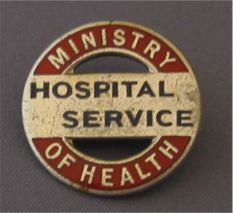Hospital Service:
By 1939 the government expected that the war would open with a 'knock-out' blow on the UK of 3,500 tons of bombs to be followed by 700 tons of bombs daily for weeks. Each ton of bombs was expected to cause 50 casualties of which one third would be fatal. The Emergency Hospital Service, which had been planned since 1938 was mobilised in the Emergency Hospital Service Act of 1939. The government financed a regional grouping of hospitals, new hospitals were opened and some city hospitals were closed to normal patients as they awaited the predicted mass of bombing victims. No one had thought about how the old system of voluntary hospitals might be reintroduced after the war and the government was to agree to the National Hospital Service - a virtual nationalisation of the system. This made the creation of the National Health Service in 1948 the next and logical step.
The badge shown here belonged to my grandmother, Olive Kathleen Barnes and is inscribed with her initials on the reverse 'OKB' and is part of my fathers collection of family memorabilia. The badge isn't numbered and no manufacturers mark is present. My grandmother was most likely an auxiliary nurse; helping with the feeding, washing and dressing of patients and perhaps even monitoring their condition by taking their temperature and pulse. In addition to these duties, my grandmother was also a volunteer fire-watcher.

From the EHW Barnes collection.